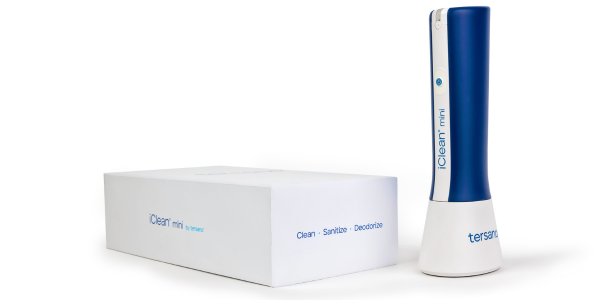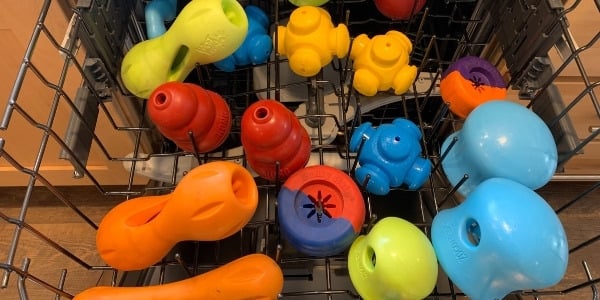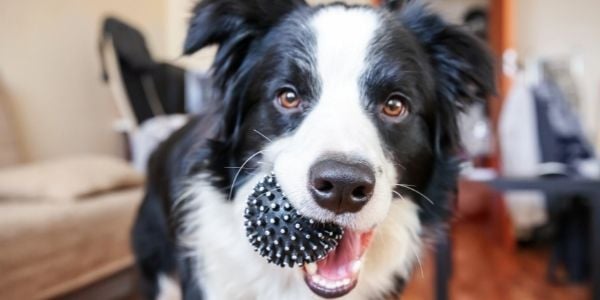
Why You Should Disinfect Dog Toys
Most dogs have a favorite toy that goes everywhere with them. That special toy gets toted throughout the house, to the yard, on walks, and to the dog park.
It gets covered in slobber, dirt, and anything else that is lingering on the ground.
This means that dog toys can be harboring anything from fungus to mold to mildew to staph bacteria. There is the risk that they can be contaminated with Parvovirus or Distemper when they are taken on walks or to the dog park. Besides all that, there is the risk of fecal contamination, which can contain E.coli or Giardia, which also puts you at risk since it can be transmitted to humans.
Skip to section:
How Often You Should Clean Your Dog's Toys
Since dog toys are among the top 10 germiest items in the home per an NSF International (National Sanitation Foundation) study1, it is a good idea to give them a good cleaning AT LEAST once a month. But in an ideal world, weekly cleaning is better.
For those toys that suffer through hard play and are covered in slobber, dirt, and who knows what else, cleaning daily is a good idea. This is especially true for those toys that have been in places other than your home and backyard.
Wash Toys Every Day If Your Dog Eats a Raw Diet
For toys that are well-loved by dogs who eat raw food diets, daily disinfection is important. Studies indicate that these diets can contain Salmonella and Listeria, which are harmful to people. If your dog loves to play with their toys right after a meal, they can be contaminated with these bacteria.
If you handle these toys and touch your mouth, you are at risk of accidental ingestion. Use caution by always washing these toys immediately after your dog has eaten and then played with them.
See the Tersano cleaner below that kills Salmonella and Listeria using water, making cleaning toys so much easier.
Life-Saving Cleaner for Everyday Use
Before you dig into the specific cleaning instructions for each type of toy, this cleaner is a must-have for everyday use.
Life is busy, and we don’t always remember when we last cleaned, let alone super-cleaned our dog’s toys. This problem can easily be solved by just spraying your dog’s toys with Tersano's iClean® mini. We have such confidence in this product as a pet-safe cleaner that we put it in our store and offer our readers 10% off (use code petsafe10 at checkout).
What I love about this product is that it is chemical-free, is effective in killing many common viruses and pathogens, and only requires tap water. It's an FDA-cleared product that has many household uses and can be used on many types of materials. It is completely safe for pets – even if they get a hold of the toy before it is fully dry.
Studies show it can reduce harmful bacteria, such as E. coli – a common bacteria found on dog toys – and Salmonella by 99.999% in 5 minutes (in as little as 30 seconds on some surfaces). Additionally, in 5 minutes, it can reduce parvovirus by 99.44%.
This process will easily allow you to disinfect your dog’s toys between heavy-duty weekly cleanings. Completely spray the toy and let it sit for 5 minutes or more. No rinsing or scrubbing is necessary. Learn more about the iClean® mini disinfecting device.
The iClean® mini also eliminates pet odors, so it's great for dog beds and plush or fabric toys.
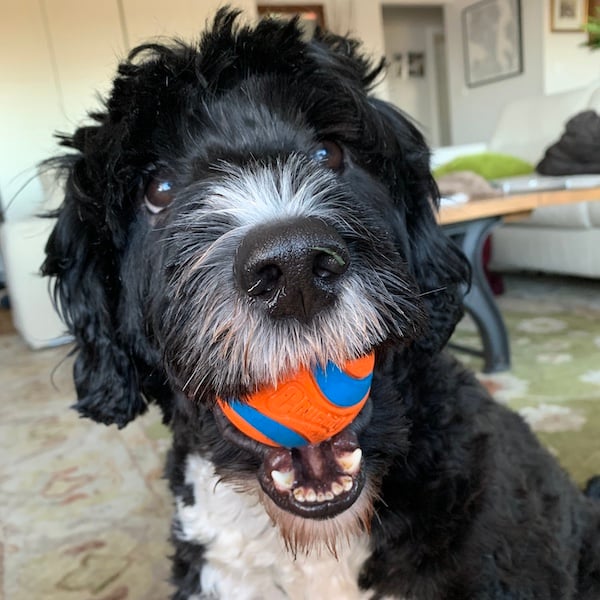
How to clean your dog’s toys is dependent on the type of toy it is. Always look at the packaging to see if the manufacturer has given any do’s and don’ts when it comes to cleaning the toy.
How to Clean Stuffed or Rope Dog Toys
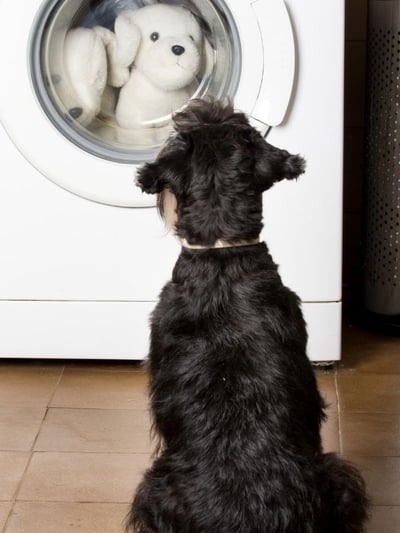
In addition to all the other gross stuff that can get on the surface of toys, stuffed toys can harbor dust mites. Getting rid of them is important because, just like us, dogs can be allergic to them.
Rope toys can be cleaned similarly to stuffed toys (details below). Typically, since they don’t have plastic pieces or glue, they can be washed in warm or hot water. There is a quick sanitization method that can be used if they aren’t dirty and there are no plastic or metal parts. Soak them for about 5 minutes in water. Wring out any excess water. Then microwave them for about a minute. Let air-dry.
Stuffed toys can often be washed in a washing machine. Choose a cycle that you think is best for those particular toys. Typically, the Delicate, Hand Wash, or Gentle cycle is the best option.
It is generally recommended to use a mesh laundry bag when washing stuffed animals. This helps protect them and keeps any pieces or parts that may have come off contained.
Hot water (at least 140 F) kills bacteria and viruses
Toys with glue, plastic pieces, crinkles, or squeakers should be washed in cool water so that the glue or other plastic parts don’t melt.
Always use the hottest water temperature possible (typically, the warm setting) that is safe for the toys. Hot water (at least 140 F) will kill bacteria and viruses. Additionally, hot water is needed to help kill dust mites.
Prior to washing, be sure to pre-treat any caked-on mud, dirt, or stains. Use a sponge or toothbrush and scrub the area using a mixture of baking soda and vinegar. There isn’t a specific proportion, but it should resemble toothpaste. Allow the area to soak after scrubbing for about 10 to 15 minutes, rinse and wash.
When washing stuffed toys, only use pet-safe detergents. You don't want ingredients like these in your detergent, as your dog will be putting these toys in their mouth:
- Bleach
- Chlorine
- Sodium lauryl ether sulfate (SLES)
- Phthalates
- Artificial Dyes
Here are some options for pet-safe laundry detergents:
- Dirty Labs Scent Free Bio-Liquid detergent
- Dropps Pods
- Clean People Fragrance Free Laundry Detergent Sheets
- Earth Breeze Laundry Detergent Sheets
- Biokleen Free & Clear Natural Liquid Laundry Detergent
- Pet Parents® PetTergent® Enzymatic Laundry Detergent for Pets
Another option as a pet-safe laundry detergent for toys and dog beds is Unique's pet bed cleaner. It doubles as a spot cleaner as well. Made in the U.S.A., like the others above, it removes tough stains with its enzymatic formula. They make other great cleaning and odor-removing products.
Natural Ways to Clean Dog Toys in the Washing Machine
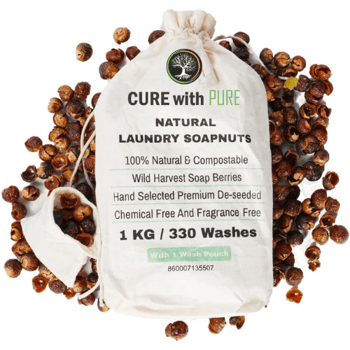
Soap Nuts
These little dried soap berries are fascinating and an ideal product to use for cleaning pet toys, towels, and beds.
Soap nuts are organic, eco-friendly, non-toxic, unscented, and chemical-free. They can even remove stains! Why is all this great? Because we don’t have to worry about our pets' sensitive skin or that they will ingest a toxin when they chew on a toy.
Besides making us feel better about using something safe and natural for our pets, we are helping the environment. These lovely little gems are reusable, fully bio-degradable, release NO CHEMICALS into the environment, and when they are used up for washing, you can compost them.
As with any cleaning agent (safe or not) or nut, for that matter, store them away safely from pets. Ingestion could cause choking, gastrointestinal upset, and blockage.
Baking Soda & Vinegar
You can skip laundry detergent altogether and use a combination of baking soda and white vinegar.
Sprinkle the toys with baking soda prior to loading them into the washing machine, and then add vinegar (a couple of capfuls). Then, put the washing machine on the rinse cycle.
Alternatively, mix one part white vinegar, two parts warm water, and a dash of lemon. Let the toys soak in the solution (about 15 to 30 minutes), and then wash in the washing machine. The mixture can be used as the detergent or use one of the other pet-friendly detergents recommended above.
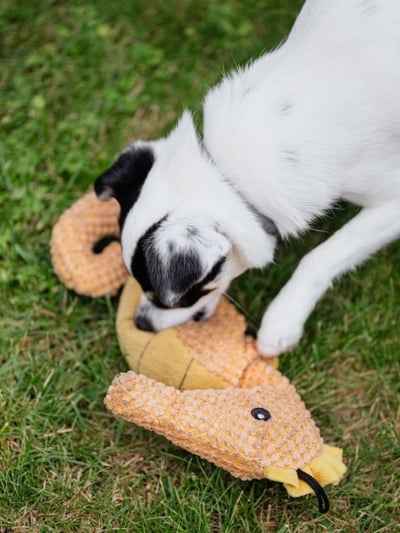
After Washing, It's Important to Dry Stuffed Toys Completely
After removing the stuffed toys from the washer, remove any excess water by gently wringing them out.
You can either air-dry them or place them in the dryer on air-dry or the lowest heat setting (do not use heat if they have any plastic).
DO NOT use scented dryer sheets. But ideally, none at all. If your pet is anxiously waiting for their toys and you drop the sheet, they may decide it is a new toy. If they ingest it, it can cause a gastrointestinal blockage. Some dogs love stealing dryer sheets as much as socks!
Be sure the toys are completely dry before they are put back into your dog’s toy bin. This is important so that they do not get moldy.
Don’t forget that toy stuffing can also be swallowed and cause intestinal blockages.
Therefore, always inspect these toys before and after washing, especially if you washed them in a washing machine. Sometimes, after cleaning them in a washing machine, the stitching can become loosened.
How to Clean Rubber, Plastic & Nylon Dog Toys
Most toys made of plastic, rubber, and nylon can be cleaned in the dishwasher, provided certain precautions are taken.
Some toys cannot be placed in a dishwasher because the high heat can cause them to warp, crack, break, or harmful chemicals (Phthalates and BPA) can be released. Prior to putting any toy in a dishwasher, be sure to do the following:
- Check the product label or the manufacturer’s website to be sure that the toy is dishwasher-safe.
- Check product labeling or the manufacturer’s website to be sure that the toys are free of any harmful or potentially deadly chemicals or materials. Ideally, for your dog's safety, you should avoid toys that are made with PVC, BPA, Phthalates, Lead, Cadmium, Chromium, Malamine, Arsenic, and Bromine.
- Use only pet-safe dishwasher detergent.
Warning: While these pods are safe for pets when used in a dishwasher, do not allow pets to play with or consume them.
- Remove any excess dirt and debris before placing in the dishwasher. Ideally, pre-scrub/clean any openings or holes with a toothbrush or bottle brush.
- You can tape over any holes or openings in order to prevent any detergents from getting inside or residue from being left behind.
- Thoroughly rinse with water after washing to remove any soap residue, and dry completely.
Don't Have or Want to Use a Dishwasher?
If you don’t have a dishwasher or you are concerned it will harm your pet’s toys, fear not because you have other options. Always remove excess dirt and debris prior to cleaning and disinfecting.
- Use pet-safe antibacterial dish soap, hot water, and a scrub brush to clean your pet’s toys in the sink. Unscented Dawn® soap is fine to use, as well as pure castile soap.
- Then, soak toys for 30 minutes in a solution of 5% vinegar to 95% warm water. Following the soak, scrub, rinse well, and air dry. Use a toothbrush to scrub areas where dirt and debris can linger.
Note: A stronger vinegar and water solution can be used (50/50).
Cleaning Dog Toys That Came Into Contact With Parvovirus or Ringworm
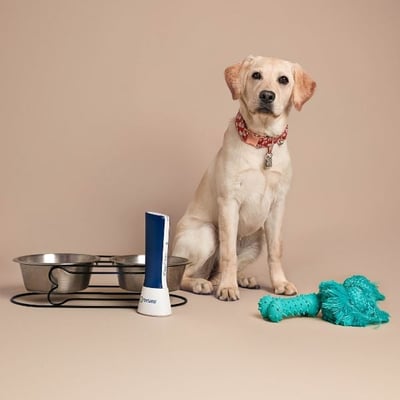 When there is concern that a dog toy may have been in contact with Parvovirus, cleaning the toy with a bleach solution has always been the ‘go-to’ cleaning option since it is highly effective and inexpensive. But not everyone wants to use it since it's strong smelling, which isn’t the best for those with respiratory issues, and it is a chemical that can be harmful if swallowed or stepped in by pets (who then lick their paws).
When there is concern that a dog toy may have been in contact with Parvovirus, cleaning the toy with a bleach solution has always been the ‘go-to’ cleaning option since it is highly effective and inexpensive. But not everyone wants to use it since it's strong smelling, which isn’t the best for those with respiratory issues, and it is a chemical that can be harmful if swallowed or stepped in by pets (who then lick their paws).
The good (actually great) news is that there is another highly effective and safe, chemical-free option, Tersano's iClean® mini – use the code petsafe10 at checkout for 10% off.
Chemical-Free Parvo Cleaning
In fact, studies show that the Tersano is 50% better than bleach. After five minutes of contact time on the toy (and any area it touched), parvovirus is reduced by 99.44%. To effectively kill parvovirus, bleach must have as long as 10 minutes of contact time, and then you must be sure to properly rinse and dry the toy.
This is a good option for disinfecting anything that may have come into contact with parvovirus. Learn more about the iClean® mini device and how it safely cleans.
For those who want to use bleach, just be sure to properly dilute it, follow the contact time requirements, and rinse the toys well!
Cleaning Parvo With Bleach
Per the ASPCA, cleaning toys with properly diluted bleach solutions and rinsing well is safe.
Download and print ASPCA's helpful bleach dilution poster and hang it over your washing machine. Until you get a chance to download it, you can do the following using 5.25% bleach (this percent will be on the product label) and water.
For general disinfection of bacteria and viruses (such as Parvovirus) for toys, you will make a 1:32 dilution:
- Find a container that tightly closes and will not break down from the bleach (i.e., an empty bleach bottle).
- Pour a ½ cup of 5.25% bleach into your container.
- Fill the container with water till you have made a full gallon. Be sure to store the solution in a safe place away from children, pets, and light.
NOTE: Toys that have been exposed to Parvovirus should be soaked for at least 10 to 15 minutes prior to rinsing and drying.
How to Clean Dog Toys Exposed to Ringworm
Any washable fabric items (such as bedding, clothes, and towels) should be washed twice at any temperature on the longest wash cycle to kill fungal spores.
After washing and drying, spray your washer and dryer inside with appropriately diluted chlorine bleach (1 pint of bleach in 1 gallon of water) or accelerated hydrogen peroxide cleaners and let them dry to kill any remaining spores.
Dishes, combs, plastic toys, and other non-porous items can be cleaned with a regular dish soap detergent until clean to kill any fungus on their surfaces.
Remember to wear gloves, long sleeves, and long pants while cleaning and wash your hands when done. Be sure to change your clothes and wash them as soon as you finish sanitizing.
The Bonus of Cleaning Dog Toys Regularly
Besides getting rid of all the ‘yucky’ stuff, cleaning also helps your toys last longer.
Regularly cleaning dog toys allows you to fully inspect them for any wear and tear. Toys that are damaged in any way can be a potential choke hazard or result in an intestinal blockage if your dog swallows a big piece or several small pieces.



